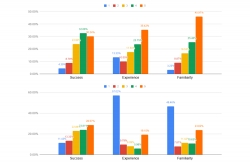Links to articles about KPIs can be found at the end of the article.
The current series of articles focuses on the important KPIs every business must monitor. I have already written many articles regarding this very important issue. However, this article focuses on shortly presented Supply Chain KPIs, with links to learn more about them in greater detail.
Part I of the series discussed KPIs every CEO must examine once a week or once a month and two additional KPIs, Quality Assurance KPI and the law of Work & Rest hours KPI, that CEOs must address every time a deviation is reported:
CEOs are accountable for the company’s profit. Managers of other disciplines are accountable for all other KPIs.
Part II of the series presents the KPIs under the responsibility of Human Resources and financial managers.
This article presents the KPIs under the responsibility supply chain managers.
Supply Chain
Supply chain refers to the process of raw materials, from the supplier to the customer, or to the point a signed delivery note is received from the customer. The responsibility for the supply chain is very often divided between several mangers. Some companies distinguish between purchasing management and finished goods transportation management. It depends on the size of the company and sometimes on the power of managers to prevent the system from becoming more efficient.
This article refers to companies with a single supply chain manager.
Following, are four KPIs that supply chain managers are responsible for when aiming to improve the supply chain process.
The second KPI is - OTIF (On Time in Full) KPI
Delivering quality products, in full and on time is an important KPI. It includes the supply chain process from beginning to end. For the customers, it is the most important factor. Customers need to receive their orders on time, in full and in the best quality. How do we know that this is the most important factor for the customers? Simply by looking at ourselves as customers and considering what is important for us. The last thing our company needs, is a supplier who delays deliveries or supplies poor quality goods. Both preventing us from meeting our own commitments to our own customers.
If we wish to keep, or better still, increase the number of our customers, not by reducing our prices, we must maintain satisfied customers. Our customers value us according to the quality of goods and service we provide. If they cannot keep their own customers satisfied because of us, they will look for more reliable suppliers and leave our business.
Measuring method:
Count the order that left your site at 100% quality, in full and on time, as was agreed with the customer when placing the order. 100% full delivery refers to the initial date promised to the customer.
Example:
- A customer order is received.
- The customer approves the delivery date promised.
- You realize you will not be able to meet the delivery date as promised and you notify the customer of the delay.
- The customer approves the new delivery date.
- 100% full delivery is counted from the first date promised to the customer.
Why take the hard line?
Our aim is to satisfy our customers so they will continue buying our products and recommend us to others. When we try to look good in our own eyes or our manager’s– we do not improve customer satisfaction
Our customers rely on our service and plan their actions in accordance with our agreements. When we change the delivery date or supply poor quality goods, we disturb their plans and ability to maintain their own customers satisfaction.
To improve OTIF KPI, supply chain managers must be responsible for: production planning and supervision, delivery dates of raw materials and packaging materials, and delivery dates of the finished goods to the end customers.
One of the conditions to reach good results of this KPI is adhering to the production plans (on which we will expand in the next article of this series) – and strictly reject customers and/or sales representatives demands to change the weekly production plan.
What must be done when none of the orders are delivered on time?
When you find yourselves in a situation where you rarely meet delivery dates, measure your backorders every day. Daily control will help improve the situation and deliver on time.
SLA - Service Level Agreement KPI
Some companies measure only Service Level (SL) as an internal KPI. These companies forget the third word “Agreement” (with the customer).
OTIF, which includes SLA level is the necessary KPI for manufacturing companies.
Excellent service is an important issue for all businesses, not only for manufacturers. It is therefore unwise to separate between OTIF and SLA KPIs in businesses that only sell goods
In businesses like restaurants, stores etc. service level is measured in a different way.
Summary of service level
The first KPI, is OTIF . It is the best KPI to measure the operational level of the supply chain. It includes suppliers, raw material stock, inventory, planning and other factors. Using it may suffice but it is advisable to use other KPIs which will help identify downfalls and help improve the process.
The second KPI is - accuracy of inventory
It expresses the level of discipline and preciseness of the company. To improve inventory management, stock must be measured extremely accurately. For example, there are 1001 items on the shelf, but the stock record indicates only 1000 items. The gaps between record and actual indicates incompatibility. Compatibility is measured at KPI 1, Incompatibility is measured at KPI 0.
Inaccurate counting may show good KPI results and therefore delude managers into thinking all is right, but it will not improve a company’s performance or serve the main aim, to improve the business. Explanation of the measuring process in the link.
The third KPI is satisfaction from our suppliers
Our business, like our customers, must work with reliable suppliers and maintain good business relations. The suppliers’ performance must therefore be monitored, and ongoing feedback must be provided. Supplier’s deliveries are measured at 1 or 0. There is no halfway. However, supporting our suppliers and helping them to serve us well is also important.
The fourth KPI is: Dead and Destroyed stock
Some of the KPIs mentioned above may cause the business to maintain large stocks of unsold goods that are eventually destroyed. To reduce dead and destroyed stocks, KPIs must include financial values and deadlines.
Destroying stock
There is no significant difference between dead stock and destroyed stock, except for the fact that dead stock occupies valuable space in the warehouse and makes it difficult to monitor the stock accurately, consistently and following the FIFO principles
Dead stock, stock which had not been destroyed, bears financial value in the company’s ledger. However, it is a fictitious value as the goods will never be sold and the value will never be realized. Destroyed stock, however, is considered an expense because it erases the fictitious financial value of the dead stock.
Some CEOs prefer to maintain dead stock to keep an appearance, either in their own eyes or the owners. Some maintain dead stock to draw higher dividends, which is determined by the board of directors in accordance with actual earnings of the company.
Osem, Nestle, a food manufacturer at Yokneam which I managed, used to destroy dead stock every quarter. Regular elimination of dead stock led to better planning and significant reduction in the volume of destroyed raw material.
At one point in my career, I coached a company which kept large engines in its warehouses, valued at thousands of shekels. The technology of these engines was long replaced, and they were never going to be used.
Some CEOs destroy dead stock immediately after assuming the CEO position so they can “blame” the financial expense written in the company’s ledger on their predecessor.
Monitoring dead and destroyed stock
I recommend regular monitoring of the financial value of dead and destroyed, and ongoing estimations of the time it will take for the stock to become slow selling or dead.
Summary and recommendations
Every company has its own emphasis, but the KPIs described above apply to all companies.
CEOs are directly responsible for three or four KPIs. The rests are cascaded to managers and employees under their responsibilities.
The KPIs under the responsibility of Supply Chain CEOs are:
- OTIF - Good quality, On Time Delivery in Full.
- Accuracy of inventory
- Satisfaction from suppliers
- Financial value of Dead and Destroyed stock
Frequency of monitoring should be daily or weekly, according to the KPI.
Remember, cutting corners may improve appearance but not the company results.
Links to articles about KPIs
- https://business-excellence.co.il/en/about-2/304-our-work-method
- https://business-excellence.co.il/en/my-blog/950-how-much-are-you-willing-to-pay-for-good-service-or-how-to-improve-your-customer-service
- Just in Time Inventory Management – is there such a thing?
- How to Manage Dead Inventory and What You Can Get Out of a Yearly Inventory-Check
- 4 Important Performance Indicators to Know
- Statistical Quality Control – What Is It? How To Use It? – The Last Chapter From My First Book
- Excellence, Quality, and Increased Profits through Employees' Involvement and Responsibility
- Does Improving the Organizational Culture Improve Profit?
- Defect analysis and solutions during production process, using fishbone method
- Improving Company Performance, Profit and Strength by Working with New Targets












 My First Book: Manage! Best Value Practices for Effective Management
My First Book: Manage! Best Value Practices for Effective Management